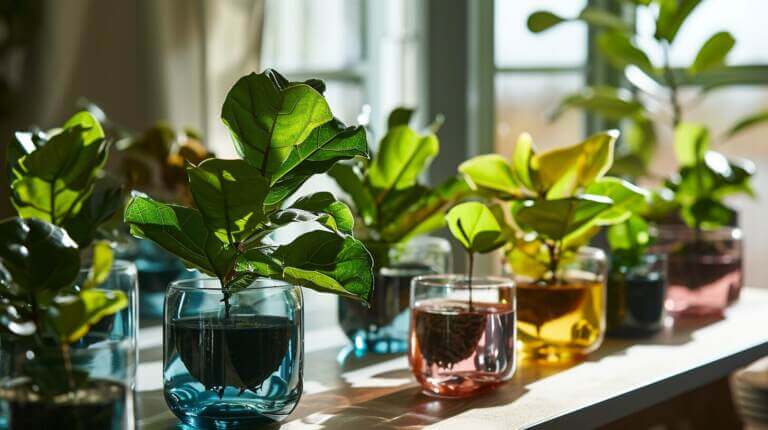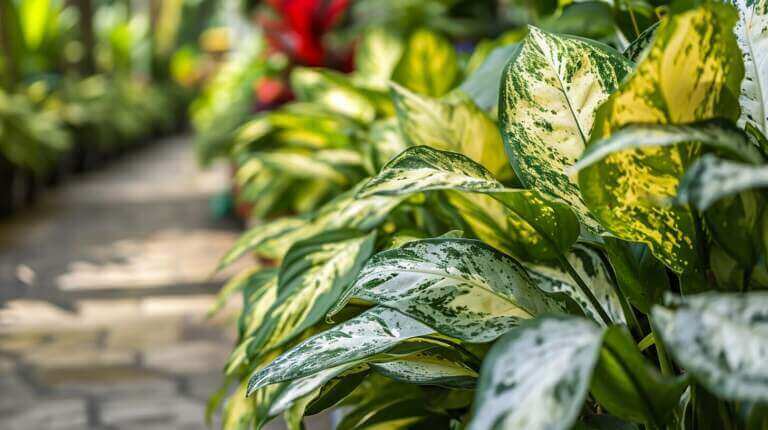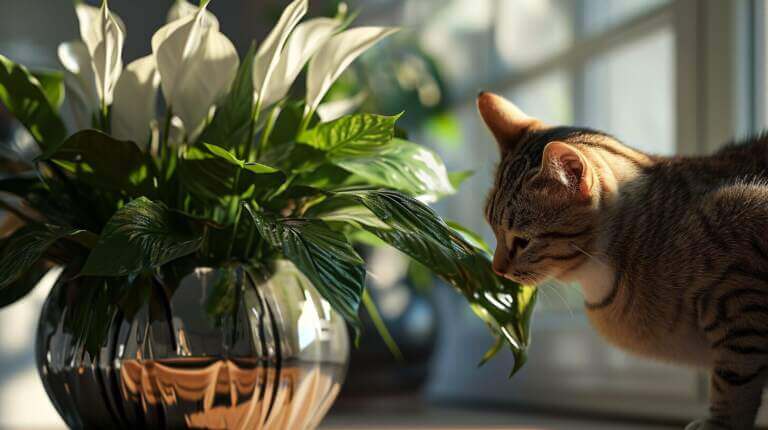Troubleshooting Common Calathea Problems: Yellow Leaves, Brown Spots, Drooping Leaves And More
Many people struggle with the care of Calathea plants due to their fussy nature, but understanding their needs can make them a delightful addition to your home. In this guide, I will help you troubleshoot common Calathea problems, such as yellow leaves, brown spots, and drooping leaves. We will explore the causes of these issues and provide you with the solutions to fix them.
Key Takeaways:
- To prevent common Calathea problems, ensure proper drainage by repotting into well-draining soil and using a planter with a drainage hole.
- Yellow leaves can be caused by overwatering, underwatering, over-exposure to sun, or plant stress. Adjust watering, provide appropriate light, and fertilize as needed.
- Leaf curling can indicate thirst, overwatering, or plant stress. Check soil moisture and ensure proper drainage to address this issue.
- Brown tips on leaves may result from watering issues, mineral build-up, or exposure to too much light. Adjust water, flush soil periodically, and provide appropriate light conditions.
- Fading leaves can be caused by lighting issues or nutrient deficiency. Adjust light conditions and provide appropriate fertilization to restore vibrancy.
Understanding Excess Moisture: The Most Common Cause of Calathea Problems
Excess moisture is the primary cause of issues with Calathea plants. Overwatering can lead to rot and bacterial or fungal infections in the roots and lower stems. It is essential to check the roots and lower stems for signs of rot and remove any affected portions. Repotting into a well-draining mixture with a planter that has a drainage hole is necessary to prevent future problems. Providing bright indirect light and lightly moist soil, while avoiding a soggy pot, will help keep your Calathea healthy.
Signs of Excess Moisture:
- Yellowing or browning leaves
- Mushy or rotten roots
- Foul odor in the soil
Excess moisture is often caused by overwatering, which can suffocate the roots and lead to root rot. It is crucial to allow the top few inches of soil to dry out before watering again. A well-draining potting mix is essential to prevent water from sitting in the bottom of the pot and causing waterlogged conditions. If you notice signs of excess moisture, such as yellowing or browning leaves, it is essential to take immediate action to prevent further damage.
Proper watering techniques are key to maintaining a healthy Calathea. Instead of following a strict watering schedule, it is best to monitor the moisture level of the soil and water when the top few inches feel dry. This will help ensure that the roots receive adequate moisture without becoming waterlogged. Additionally, providing bright indirect light will help your Calathea thrive and reduce the risk of excess moisture-related problems.
| Causes of Excess Moisture | Solutions |
|---|---|
| Overwatering | Allow the top few inches of soil to dry out before watering again. Repot into a well-draining mixture with a drainage hole. |
| Poor drainage | Ensure that the pot has a drainage hole and use a well-draining potting mix. |
| High humidity | Monitor the humidity levels and provide adequate air circulation. |
Understanding Yellowing Leaves: Causes and Solutions
Yellowing leaves in Calathea plants can be caused by various factors. Overwatering is a common culprit, especially if the soil is not well-draining. Natural shedding of lower leaves is a normal process, but if yellowing occurs at an alarming rate, it may indicate over-exposure to sun or plant stress due to changes in the environment. Consistent underwatering or over- or underfeeding can also lead to yellow leaves. Adjusting watering, providing appropriate light, and fertilizing as needed can help address these issues.
Common Causes of Yellowing Leaves:
- Overwatering: Poor drainage and excessive moisture can cause root rot, leading to yellowing leaves.
- Natural Shedding: Calathea plants naturally shed older leaves, which may turn yellow before falling off.
- Over-Exposure to Sun: Direct sunlight or intense light can cause stress and yellowing of leaves.
- Plant Stress: Changes in temperature, humidity, or other environmental factors can stress the plant, resulting in yellowing leaves.
- Underwatering: Insufficient watering can cause the plant to become dehydrated, leading to yellow leaves.
- Over- or Underfeeding: Imbalanced or inadequate nutrients can affect leaf health, causing yellowing.
To address yellowing leaves in your Calathea plant, it’s essential to identify the underlying cause. Begin by assessing the watering routine and adjusting it accordingly. Ensure the soil has good drainage to prevent overwatering or underwatering. Place the plant in an area with bright indirect light, avoiding direct sunlight. Maintain a consistent environment to reduce plant stress. If necessary, fertilize the plant with a balanced fertilizer suitable for Calatheas. By addressing these factors, you can help restore the health and vibrancy of your Calathea’s leaves.
| Cause | Solution |
|---|---|
| Overwatering | Improve drainage and adjust watering schedule to avoid excessive moisture. |
| Natural Shedding | Monitor the rate of leaf yellowing and ensure new growth is healthy. |
| Over-Exposure to Sun | Move the plant to a location with bright indirect light. |
| Plant Stress | Maintain consistent temperature, humidity, and other environmental conditions. |
| Underwatering | Water the plant thoroughly, allowing the soil to drain properly. |
| Over- or Underfeeding | Fertilize the plant with a balanced fertilizer suitable for Calatheas. |
Understanding Leaf Curling: Causes and Solutions
Leaf curling in Calathea plants is a common issue that can be caused by various factors. It is important to determine the cause of leaf curling in order to provide the appropriate solution and ensure the health of your plant. Leaf curling can be a sign of thirst, indicating that the plant needs more water. However, it can also be a result of overwatering or plant stress. Testing the soil moisture and ensuring proper drainage can help determine the cause and adjust your watering schedule accordingly.
Another possible cause of leaf curling is soil compaction. When the soil becomes compacted, it can interfere with the plant’s ability to absorb water and nutrients, leading to leaf curling. Loosening the soil or repotting the plant in fresh, well-draining soil can help alleviate this issue.
Plant stress can also contribute to leaf curling. Factors such as extreme temperatures, low humidity, or exposure to drafts can put stress on the plant, causing the leaves to curl. Providing a stable environment with appropriate temperature and humidity levels can help prevent leaf curling due to plant stress.
| Cause | Solution |
|---|---|
| Thirst | Ensure adequate watering and maintain appropriate soil moisture levels. |
| Soil Compaction | Loosen the soil or repot the plant in fresh, well-draining soil. |
| Plant Stress | Provide a stable environment with appropriate temperature and humidity levels. |
Understanding Brown Tips: Causes and Solutions
Brown tips on Calathea leaves can be a common issue and are often a sign of underlying problems. By understanding the causes of brown tips and implementing the right solutions, you can help keep your Calathea plants healthy and vibrant.
Watering Issues
One of the main causes of brown tips on Calathea leaves is improper watering. Both underwatering and overwatering can lead to this issue. Underwatering can cause the plant to become dehydrated, while overwatering can result in waterlogged soil and root rot.
To prevent brown tips caused by watering issues, it is important to establish a consistent watering routine. Check the moisture level of the soil regularly by sticking your finger about an inch deep into the soil. If it feels dry, it’s time to water your Calathea. However, if it feels moist or wet, hold off on watering until the soil has a chance to dry out.
Mineral Build-Up
Another potential cause of brown tips is mineral build-up in the soil. Over time, minerals from water and fertilizers can accumulate in the soil, leading to nutrient imbalances and brown tips on the leaves.
To address mineral build-up, periodically flush the soil with distilled water or rainwater to help remove excess minerals. You can do this by thoroughly watering the plant until water runs out of the drainage holes, ensuring that the excess minerals are flushed away. Additionally, consider using distilled water or filtered water for regular watering to prevent further build-up of minerals.
Light Exposure and Damaged Leaves
Calathea plants thrive in bright indirect light. However, too much exposure to direct sunlight can cause the leaves to burn and develop brown tips. Additionally, physical damage to the leaves, such as tearing or bruising, can also result in brown tips.
To prevent brown tips due to light exposure, place your Calathea in a location where it receives bright indirect light, such as near a north or east-facing window. If your plant is exposed to direct sunlight, consider using sheer curtains or blinds to filter the light or moving it to a slightly shadier spot.
Ensure that you handle the leaves of your Calathea plants with care to avoid any damage that could lead to brown tips. Trim off any heavily damaged leaves to promote the growth of new healthy foliage.
Understanding Fading Leaves: Causes and Solutions
Fading leaves in Calathea plants can be a cause for concern. The vibrant colors and patterns that make these plants so appealing may gradually fade, leaving the leaves looking dull and lackluster. Understanding the causes of fading leaves and implementing appropriate solutions can help restore the beauty and vibrancy of your Calathea.
One common cause of fading leaves in Calathea plants is lighting issues. These plants thrive in bright indirect light, but exposure to too much or too little light can lead to faded foliage. If your Calathea is placed in a spot with inadequate light, consider moving it to a brighter location. On the other hand, if it’s receiving direct sunlight, try placing it in a spot with filtered light to avoid excessive exposure.
Nutrient deficiency can also contribute to fading leaves in Calathea plants. These plants require regular fertilization to replenish essential nutrients in the soil. If the leaves are fading, it may be a sign that the plant is not receiving adequate nutrients. Consider adding a balanced liquid fertilizer to the soil according to the manufacturer’s instructions to provide the necessary nourishment.
Table: Common Causes and Solutions for Fading Leaves in Calathea Plants
| Causes | Solutions |
|---|---|
| Excessive exposure to direct sunlight | Move the plant to a spot with filtered or indirect light |
| Inadequate lighting | Place the plant in a brighter location |
| Nutrient deficiency | Add a balanced liquid fertilizer to the soil |
Understanding Calathea “Melting”: Root Rot Progressing to Stem Rot
The beautiful and delicate Calathea plants can be prone to a condition known as “melting” if not properly cared for. This phenomenon occurs when root rot progresses to stem rot due to overwatering. It is important to recognize the signs of this condition and take immediate action to prevent further damage.
Signs of Calathea “Melting”
Calathea “melting” typically starts with root rot, which is caused by overwatering the plant. The excess moisture in the soil leads to the roots becoming mushy and susceptible to rot. If not addressed promptly, the rot can spread to the stem, resulting in the complete deterioration of the plant. Common signs of Calathea “melting” include:
- Yellowing and wilting of leaves
- Mushy and discolored roots
- Soft and rotting stems
Preventing Calathea “Melting”
To prevent Calathea “melting,” it is crucial to avoid overwatering the plant. Calatheas prefer slightly moist soil but can suffer from root rot if watered excessively. Here are some tips to prevent this condition:
- Ensure that the pot has proper drainage to allow excess water to escape.
- Water the plant only when the top inch of soil feels dry.
- Avoid leaving the pot sitting in a saucer of water.
- Provide adequate light and airflow to the plant to promote healthy growth.
Rescuing an Affected Calathea
If your Calathea is already showing signs of “melting,” immediate action is necessary to salvage the plant. Follow these steps:
- Carefully uproot the plant and gently remove any mushy or discolored roots.
- Trim any soft and rotting stems, ensuring that you make clean cuts.
- Repot the plant in fresh, well-draining soil, and provide proper care moving forward.
By understanding the causes and taking preemptive measures, you can help your Calathea thrive and avoid the devastating effects of “melting.”
Understanding Bug Invasion: Common Pests and Solutions
Dealing with bug invasions is a common challenge when it comes to caring for Calathea plants. These beautiful houseplants can attract pests like spider mites, thrips, and mealybugs, which can wreak havoc on their health. Recognizing the signs of a bug invasion and taking swift action is crucial to keeping your Calathea thriving.
Spider mites are tiny pests that can infest your Calathea, causing noticeable discoloration and web-like structures on the leaves. Thrips are another common pest that feeds on the plant sap, leaving behind silver-gray speckles and deformed leaves. Mealybugs, on the other hand, appear as small white cottony masses on the stems and undersides of leaves, eventually causing yellowing and stunted growth.
To control bug invasions, it’s important to regularly inspect your Calathea and take immediate measures. One effective method is using insecticidal soap or horticultural oil, which can suffocate and eliminate the pests. Additionally, maintaining a clean and healthy environment for your plant, including proper watering and adequate air circulation, can help prevent bug infestations.
FAQ
Why are my Calathea leaves turning yellow?
The leaves of your Calathea may turn yellow due to overwatering or lack of humidity. Overwatering can lead to root rot, which in turn causes the leaves to turn yellow.
What causes brown spots on Calathea leaves?
Brown spots on Calathea leaves can be a sign of a fungus gnat infestation. These pests feed on the roots of the plant, causing damage that can lead to brown spots on the leaves.
Why do Calathea leaves droop?
Calathea leaves may droop due to a lack of water or humidity. If the plant is not receiving enough water, the leaves will start to droop. Similarly, if the humidity levels are too low, the leaves may also droop.
How do I care for my Calathea plant?
Calathea care involves providing the plant with high humidity, indirect light, and regular watering. It’s also important to use tap water that has been left out for 24 hours to allow the chlorine to evaporate.
Why are the edges of my Calathea leaves turning brown?
The edges of Calathea leaves can turn brown due to a lack of humidity. Calatheas are tropical plants and thrive in high humidity environments.
What causes the leaves of my Calathea to curl?
Curling leaves on a Calathea can be a sign of underwatering. If the plant is not receiving enough water, the leaves will start to curl.







